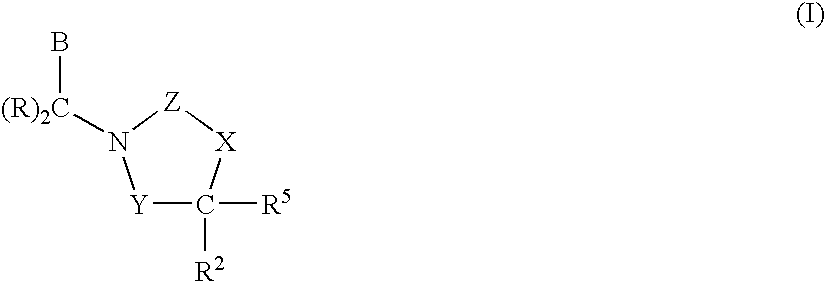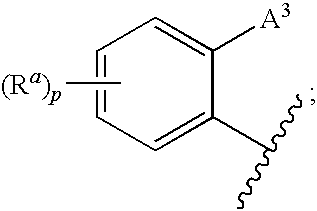1,3-Oxazolidin-2-One Derivatives Useful as Cetp Inhibitors
a technology of oxazolidin and derivatives, which is applied in the direction of biocide, drug composition, metabolic disorders, etc., can solve the problems of statins only achieving a risk reduction of approximately one-third, and the burden on the health care system is truly enormous
- Summary
- Abstract
- Description
- Claims
- Application Information
AI Technical Summary
Problems solved by technology
Method used
Image
Examples
example 1
[0344]
(4S,5R)-5-[3,5-bis(trifluoromethyl)phenyl]-3-{[6′-methoxy-4-(trifluoromethyl)-1,1′:3′,1″-terphenyl-2-yl]methyl}-4-methyl-1,3-oxazolidin-2-one
Step A
[0345]
(4S,5R)-5-[3,5-bis(trifluoromethyl)phenyl]-3-{[5′-bromo-2′-methoxy-4-(trifluoromethyl)biphenyl-2-yl]methyl}-4-methyl-1,3-oxazolidin-2-one
[0346]A mixture of (4S,5R)-5-[3,5-bis(trifluoromethyl)phenyl]-3-[2-iodo-5-(trifluoromethyl)benzyl]-4-methyl-1,3-oxazolidin-2-one (6-80 g, 11.39 mmol), 2-methoxy-5-bromo-phenyl boronic acid (3.00 g, 12.99 mmol), and sodium carbonate (2.65 g, 25.0 mmol) in 200 ml of 1:2:4 mixture of water:EtOH:toluene was stirred at room temperature for 30 min. Catalytic amount of tetrakis(triphenylphosphine) palladium (0.66 g, 5% mol) was added. The mixture was stirred under reflux for 24 h. TLC (CH2Cl2:hexane / 1:1) showed no starting material. The solvents were removed. Water (100 ml) was added. The mixture was extracted with methylene chloride (3×100 ml). The combined methylene chloride layers were washed wit...
example 21
[0349]
Step A
[0350]
(4S,5R)-5-[3,5-bis(trifluoromethyl)phenyl]-3-{[2′-methoxy-5′-(4,4,5,5-tetramethyl-1,3,2-dioxaborolan-2-yl)-4-(trifluoromethyl)biphenyl-2-yl]methyl}4-methyl-1,3-oxazolidin-2-one
[0351](4S,5R)-5-[3,5-bis(trifluoromethyl)phenyl]-3-{[5′-bromo-2′-methoxy-4-(trifluoromethyl) biphenyl-2-yl]methyl}-4-methyl-1,3-oxazolidin-2-one (500 mg, 0.762 mmol), bis(pinacolato)diboron (388 mg, 1.53 mmol), 1,1′-bis(diphenylphosphino)ferrocene-palladium dichloride dichloromethane adduct (150 mg, 0.184 mmol), potassium acetate (150 mg, 1.53 mmol) and 1,4-dioxane (5 mL) were sealed in a microwave vessel. The reaction mixture was irradiated by microwave to 140° C. for 40 minutes. Additional bis(pinacolato)diboron (388 mg, 1.53 mmol) was added followed by microwave irradiation at 140° C. for 20 minutes. Then additional potassium acetate (150 mg, 1.53 mmol) was added followed by microwave irradiation at 140° C. for 20 minutes. The reaction crude was worked up with water. The resulting mixture ...
example 22
[0354]
(4S,5R)-5-[3,5-bis(trifluoromethyl)phenyl]-3-{[6′-chloro-2″-methyl-4-(trifluoromethyl)-1,1′:3′,1″-terphenyl-2-yl]methyl}-4-methyl-1,3-oxazolidin-2-one
Step A
[0355]
(4S,5R)-5-[3,5-bis(trifluoromethyl)phenyl]-3-{[2′-chloro-5′-nitro-4-(trifluoromethyl)biphenyl-2-yl]methyl}-4-methyl-1,3-oxazolidin-2-one
[0356]A mixture of (4S,5R)-5-[3,5-bis(trifluoromethyl)phenyl]-3-[2-iodo-5-(trifluoromethyl)-benzyl]-4-methyl-1,3-oxazolidin-2-one (1.0 g, 1.68 mmol), 2-chloro-5-nitro phenyl boronic acid (0.67 g, 3.3 mmol), tetrakis(triphenylphosphine) palladium (97 mg, 5% mol) and sodium carbonate (0.39 g, 3.68 mmol) in 50 ml of water / EtOH / toluene (1:2:4) was heated to reflux for 4 h. TLC(CH2Cl2:hexane / 1:1) showed that the reaction was complete. The solvents were removed. Water (30 ml) was added. The organic was extracted with methylene chloride (3×40 ml). The combined methylene chloride layers were washed with brine, and dried over sodium sulfate. The title compound was obtained after flash column u...
PUM
| Property | Measurement | Unit |
|---|---|---|
| density | aaaaa | aaaaa |
| volume | aaaaa | aaaaa |
| volume | aaaaa | aaaaa |
Abstract
Description
Claims
Application Information
 Login to View More
Login to View More - R&D
- Intellectual Property
- Life Sciences
- Materials
- Tech Scout
- Unparalleled Data Quality
- Higher Quality Content
- 60% Fewer Hallucinations
Browse by: Latest US Patents, China's latest patents, Technical Efficacy Thesaurus, Application Domain, Technology Topic, Popular Technical Reports.
© 2025 PatSnap. All rights reserved.Legal|Privacy policy|Modern Slavery Act Transparency Statement|Sitemap|About US| Contact US: help@patsnap.com



